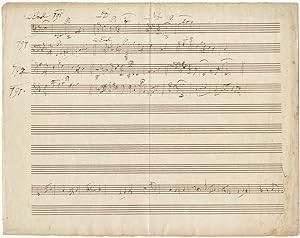About this Item
Large oblong quarto (241 x 309 mm.). Notated in dark brown ink on the verso of the second leaf of a bifolium (i.e., page 4) on 10-stave rastrum-ruled paper of British manufacture. Watermark dated 1794. Late spring or early summer, 1795 (see H.C. Robbins Landon: Haydn Chronicle and Works, Volume III, p. 495). With pencilled note in another hand to first page: "Haydn autograph notes of the 12 English Symphonies. Haydn misquotes the 2nd." Very slightly worn, browned, and soiled; minor foxing and very short splits to central fold; vertical crease to center of bifolium; lower edge with several miniscule tears. In addition to noting the musical incipits, which comprise 25 measures spread out over 4 staves, Haydn identifies the key, time signature, and year in which each symphony was first performed (in noting the performance date of Symphony 97, however, Haydn makes an error and cites 1791 instead of 1792). The sketch for the piano trio Hob. XV:25 is notated 5 staves below the symphonic incipits and consists of 9 measures of melodic material for the famous third movement. Provenance Leo Liepmannssohn auction catalogue, Berlin, 1907, lot 91; Sotheby's auction catalogue, The Westley Manning Collection, London, 12 October 1954, lot 207; J. A. Stargardt, Marburg; Elkin Mathews, London. The London Symphonies were commissioned by the London impresario and violinist Johann Peter Salmon (1745-1815) and composed over the period 1791-95. Salmon was responsible for bringing Haydn to London where he became immensely popular, largely through performances of his music at Salmon's concerts. "Haydn s London symphonies (nos. 93-104) crown his career as a symphonic composer. Not only do they outdo the Paris symphonies stylistically, but he produced them in person for rapturous audiences; this interaction stimulated him to ever bolder and more original conceptions. . The last six [London] symphonies are even more brilliant [than the first six]. . Haydn s determination to conquer new territory with each work is palpable." James Webster in Grove Music Online "The finale of Hob. XV:25 is the famous rondo "in the Gypsies Style." It seems that a composer's most popular works, if not spurious, are at least unusual manifestations of his style, and this rondo fits this characterization. . Even though this finale was best known during the eighteenth century as a separate piece in many different settings, its impact is best appreciated within the context of this keyboard trio cycle, for the Andante and Poco Adagio (the first and second movements) hardly prepare one for its burst of energy." A. Peter Brown: Joseph Haydn's Keyboard Music Sources and Styles, p. 377. ". the G major Trio (39) turned out to be Haydn's most popular piano piece, because of the 'Gypsy Rondo' Finale. . [It] became an enormous favourite, first in England and immediately afterwards on the Continent." Robbins Landon III, pp. 431-32. A unique and interesting manuscript, being a virtual catalogue of all the London Symphonies and including music from the famous Gypsy Rondo, some of Haydn's best music from his important London period. Seller Inventory # 39430
Contact seller
Report this item
![]()
